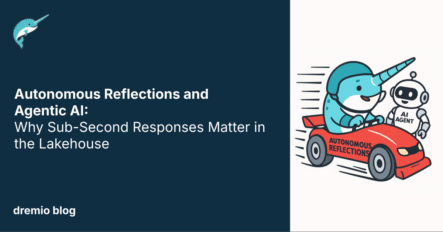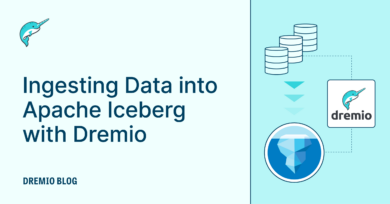5 minute read · September 17, 2025
Autonomous Reflections and Agentic AI: Why Sub-Second Responses Matter in the Lakehouse
· Head of DevRel, Dremio

When people interact with AI copilots or conversational agents, expectations are high. We want answers that are not only accurate but also instantaneous. In the enterprise world, this means your data platform must deliver sub-second query responses, even on massive datasets.
This is where Dremio’s autonomous reflections play a critical role. By combining performance optimization with governance and AI-ready semantics, they ensure agents can deliver a smooth, natural experience every time.
Why Speed Matters for Agentic AI
For AI agents, latency isn’t just an inconvenience, it breaks the experience.
- Conversational flow: If queries take more than a few seconds, users lose trust in the agent’s ability.
- Complex workloads: Agentic AI often chains multiple queries together; delays compound quickly.
- Adoption barrier: Business users expect the speed of Google Search, not the wait times of traditional BI dashboards.
To achieve this, your lakehouse needs intelligent, self-optimizing acceleration.
What Are Reflections?
In Dremio, reflections are materialized representations of data designed for query acceleration.
- Raw Reflections: Store data in a physical copy for faster access.
- Aggregated Reflections: Pre-compute metrics to eliminate expensive runtime calculations.
Agents (and humans) don’t need to know which reflection is being used, the query planner automatically substitutes the optimal reflection to satisfy the request.
From Manual Tuning to Autonomous Optimization
Traditional performance layers require manual tuning: defining cubes, scheduling refreshes, and constantly adjusting to new query patterns.
Dremio’s autonomous reflections remove that burden:
- Automatic detection of new query patterns.
- Dynamic updates to ensure reflections evolve with usage.
- Transparent acceleration that requires no changes to user queries.
This autonomy is especially vital for AI agents, which may generate unpredictable query patterns based on natural language prompts.
Sub-Second Responses in Practice
By pairing autonomous reflections with semantic search, agents can:
- Deliver instant answers to plain-language business questions.
- Scale performance across federated sources and Iceberg tables.
- Support multi-step agent reasoning without introducing latency bottlenecks.
The result: AI systems that feel as responsive as human conversation, while still grounded in governed, consistent definitions.
Conclusion
In the AI era, speed is the differentiator. Dremio’s autonomous reflections make it possible to achieve sub-second responses without endless tuning or fragile performance layers.
For enterprises, this means their AI copilots and analytics agents can deliver insights that are not only fast but also governed, consistent, and business-friendly.
When reflections become autonomous, the lakehouse truly becomes AI-ready.
See Dremio’s Intelligent Lakehouse Features First Hand by Signing up for a Workshop.
Try Dremio’s Interactive Demo
Explore this interactive demo and see how Dremio's Intelligent Lakehouse enables Agentic AI


